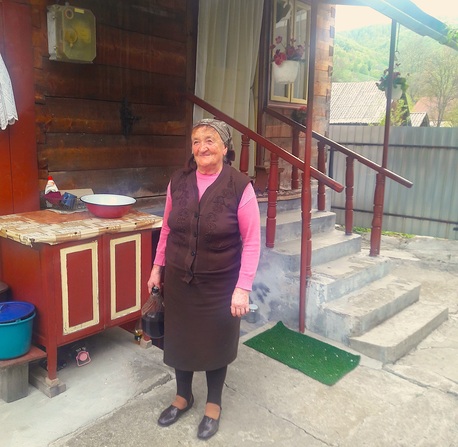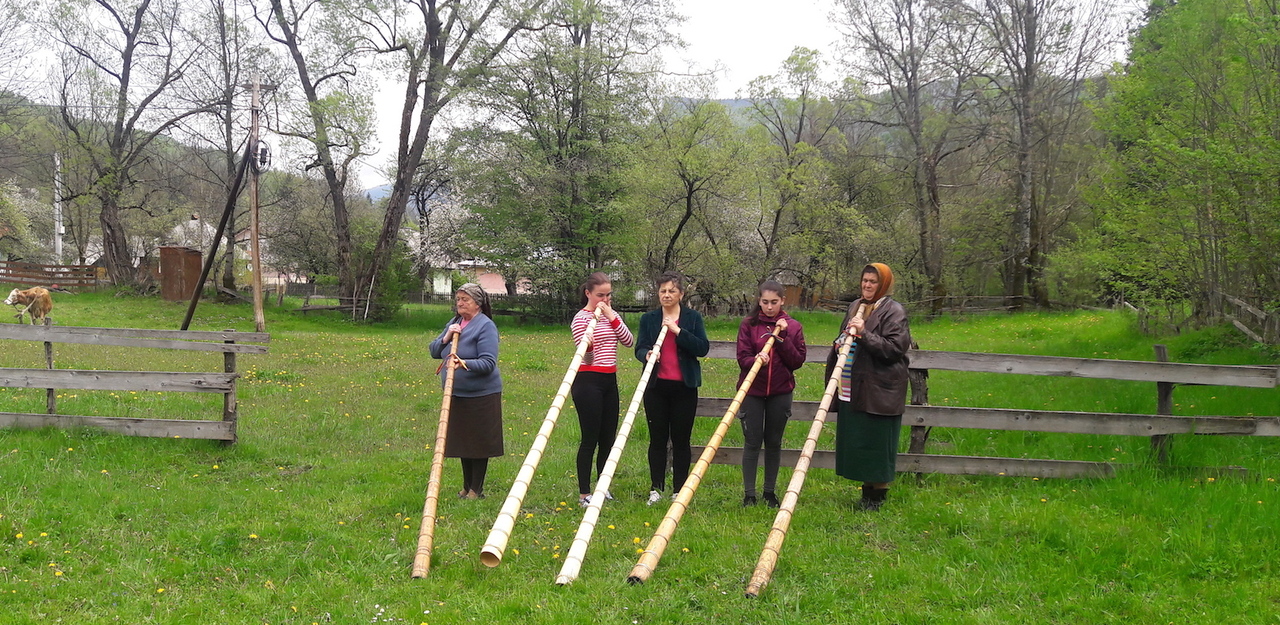
Maria Coroiu in front of her house
One of the evenings we spent in the Apuseni Mountains, we paid a visit to Mrs. Maria, at her home. She is the ”rock star” of the group of tulnic players. She lives in a modest house in the village of Avram Iancu.
We sat at a table in the front room of the house. She has no TV set, just a radio. She spends her time a few weeks here, then a few weeks in Alba Iulia, with her children.
Maria has been playing tulnic since she was ten years old. She was born in 1937. “Older girls had tulnic instruments. This is how I was born, with such instrument. People would take the cattle up into the mountains and they would play the tulnic. So, my parents made me a tulnic, a smaller one, like that. I started playing it, little by little. As I grew up, my parents bought me longer and longer tulnic instruments, until I got a tulnic that was two and a half meters long. I’ve been playing it for 60 years now. It didn’t take me too long before I could play it, because, when you are little, you learn right away. You should know, we didn’t learn any music notes. We learned how to play.”
Mrs. Maria had a teacher,
Elena Pogan (June 20th, 1925 – December 13th, 2010), a very important Romanian tulnic player.
“She taught me a lot of things about the tulnic. How to hold it, how to play tones. I played a lot of shows with Elena. Then, she died and I started playing with a man, Mihai Duma. He played...there wasn’t a woman in the village who could play like that lad. He would play the tulnic when he was out with the cattle; he played the tulnic, as well as the torogotă (Turkish pipe). He was great. I went in a lot of places with Mihai as well, we even played in other countries: Zagreb, Ohrid, Serbia, Switzerland, and another country, which I don’t remember. Austria, yes. And throughout the country, as part of an ensemble from Alba Iulia.”
“If you like music and you have an ear for music, you can learn to play the tulnic instrument in a few months; if you practice daily.”
“I would sing a song, Elena would keep the tone, then she would sing a song, and I would keep the tone. And then we both played. The same song, but we would sing it in such a way that one tulnic would be heard. I did not play louder and she did not play softer, it was the same tulnic, the same sound. I recently played with Lenuța - part of the tulnic ensemble - at a recent celebration, and we got first prize (…). We can play these songs clearer than the young girls, you probably noticed this.”
Mihai Duma was the only
moț in the Apuseni Mountains who could play the tulnic. He received awards at several competitions in Romania and in other Balkan states, as Mrs. Maria tells us, as she treats us with some țuică and syrup, with which she makes an alcoholic drink named vișinată, kind of a nice liquor.
“A lot of women played the tulnic tremendously well, but not one like this man, Mihai Duma, with whom I played for 40 years. There are a lot of women here who play the tulnic, but the younger ones don’t play anymore. They’re not interested in the tulnic anymore. As for women under my age, there are too few of them left.”
“For me, the tulnic is joy. Look at my age - to go around with a tulnic and play - it’s not too easy. The young ones don’t seem to realize the value that the tulnic can bring.”
When speaking of the history of tulnic, one should mention
Maria Ana Gligor, one of the most well-known tulnic player, who has recently been included in the UNESCO living human heritage. “Maria Ana Gligor lives in Câmpeni, she sings different songs, which are more special, I don’t know how to tell you, she doesn’t play what we play”.
Is it true that up here, in the Apuseni Mountains, women work harder than men? “Well, they work, you know, they work. Men work in these places, they used to go farther and work wooden barrels, kegs to put brandy in; they used to go with them in the countryside and sell them where there were grapevines, where people made wine, where plum trees grew and people made țuică, our men used to go in such places and sell kegs. Women would stay at home, with the children, with the cattle, with the household, working the field. They didn’t have jobs, getting paid and the likes, they would live off the land. And men would make barrels and go around selling them.”
Why do only women play the tulnic? “Men...only Mihai Duma used to play. Men do other things. They had other jobs, they didn’t learn how to play. Men don’t want to play, they don’t need it. I remember there were some boys from around here, from the school, who wanted someone to teach them how to play, they played until one day other colleagues came and told them ”What, you’re gonna go places and play the tulnic? But you’re not Mihai Duma.” And that was it; they never touched the tulnic, they didn’t want to. The tulnic, I think this is an instrument for women. For women up in the mountains, with the cattle.”
“In the evenings, at home, we had sittings, we called them
turcării. We would spin hempseed and go outside the house, and play the
tulnic; two or three women. We would sit like that until 2-3 AM. We would spin, we would weave, we would make skirts, blouses, out of hempseed, we weaved them in looms, we used to spin them, whiten them and weave them in the loom. We wove for us and for the little ones; all homes had five or six children. Now they’re gone. Some families had as many as twelve or fifteen children.”
“The tulnic will disappear, this is what I believe. The young ones don’t...girls are not interested in playing the tulnic anymore. There are still a few of us here, who like the tulnic, but no... it’s on its way out. They don’t like playing it. Not one bit. And they don’t want to learn. And even if you tell them that they must learn, they still don’t want to learn.”
Born in 1937, Mrs. Maria remembers World War II as well. “The Russians came then. The Russians came to protect us from the Hungarians. They used to make a lot of brandy in the boilers back then. A neighbor of mine had about a cauldron of brandy – I didn’t stay here always, I used to live up on the hill, about a kilometer away from here. He had a lot of barrels full of brandy, in a cellar, God forbid. Thousands of liters. The Russians smelled it. They came before the Hungarians, to protect us, with high commanders. If the Russians hadn’t come, we would have been doomed. And the Russians smelled it. And this man couldn’t stay home, he came to us. I was little, so were my brothers. And he came to the man in charge, to my parents, to ask for an axe, so he could break the door and get some brandy from there. But he spoke their language, and they never came back. I remember all they needed was polenta with milk and cheese. And mom used to make forty polentas at a time, she made polentas all night long back then.”
”You know what’s missing? Some of us have pensions that are too low. What can you do with 640 lei?
-around 136 EUR - My husband died eight years ago. The boyars living it big, they have all the money in the world, and we have almost nothing.”
“Mountain air helps us. We have the forests here, that keep this air clean. I have only one child, a boy. They have a boy as well, and he is married, and their boy has two kids. I’m a great grandmother!”, Mrs. Maria laughs. ”I don’t get bored. Not one bit. I keep calm. I read from my prayer books every now and then, I listen to this small radio. I have no TV.”






